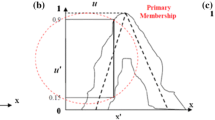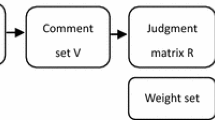Abstract
Hydraulic fracturing technologies revolutionize the way petroleum industries drill the conventional and unconventional formations by the purpose for oil recovery enhancement. Multi-criteria decision-making (MCDM) methods are always considered as the preferable techniques in organizational and industrial operational performances that some of them are being widely administered for numerous purposes. The objective of this comprehensive study is to conduct an investigation about the considerable influence of five important criteria on the hydraulic fracturing techniques and select the best technology regarding enhancing oil recovery factor. Fuzzy Analytic Hierarchy Process (FAHP) and Fuzzy Technique for Order Preference by Similarity to Ideal Solution (FTOPSIS) analyses are applied to compare each criterion. Consequently, among the five fundamental criteria for selecting and operating hydraulic fracturing, in situ stress-strain with the score weight of 0.421 is the most important selectivity criteria. Furthermore, after analyzing the results derived from FAHP and FTOPSIS methods, hydra-jet fracturing and zipper fracturing techniques with the normalized weights of 0.186 and 0.194, and relative closeness coefficients of 0.69 with a 0.66 are considered respectively as the best and optimum techniques of hydraulic fracturing. Last but not least, the cavitation hydro-vibration fracturing and explosive fracturing are the least preferable methods among hydraulic fracturing techniques.

Similar content being viewed by others
References
Al-Nakhli AR, Abass HH, Al-Ajwad HA, Kwak HT, Al-Harith AM, & Al-Otaibi A (2013). Unconventional gas stimulation by creating synthetic sweetspot. Paper presented at the SPE Unconventional Gas Conference and Exhibition
Amin SS, & Rajhans MN (2016). Application of integrated AHP and TOPSIS method for prioritization and selection of suppliers: case study in automotive industry
Amini M, Chang S, & Malmir B (2016). A fuzzy MADM method for uncertain attributes using ranking distribution. Paper presented at the Proceedings of the Industrial and Systems Engineering Research Conference
Aslani A, Aslani F (2012) Application of fuzzy AHP approach to selection of organizational structure with consideration to contextual dimensions. Organizacija 45(5):246–254
Bandara K, Ranjith P, Rathnaweera T, Perera M, Kumari W (2018) Thermally-induced mechanical behaviour of a single proppant under compression: insights into the long-term integrity of hydraulic fracturing in geothermal reservoirs. Measurement 120:76–91
Cheremisinoff NP, & Davletshin A (2015). Hydraulic fracturing operations: handbook of environmental management practices: John Wiley & Sons
Daneshy AA (2009). Factors controlling the vertical growth of hydraulic fractures. Paper presented at the SPE Hydraulic Fracturing Technology Conference
Davarpanah A (2018a) Feasible analysis of reusing flowback produced water in the operational performances of oil reservoirs. Environ Sci Pollut Res 25(35):35387–35395
Davarpanah A (2018b) A feasible visual investigation for associative foam >⧹ polymer injectivity performances in the oil recovery enhancement European Polymer Journal 105:405–411. https://doi.org/10.1016/j.eurpolymj.2018.06.017
Davarpanah A (2018c) The feasible visual laboratory investigation of formate fluids on the rheological properties of a shale formation International Journal of Environmental Science and Technology. https://doi.org/10.1007/s13762-018-1877-6
Davarpanah A, Mirshekari B, Jafari Behbahani T, Hemmati M (2018) Integrated production logging tools approach for convenient experimental individual layer permeability measurements in a multi-layered fractured reservoir Journal of Petroleum Exploration and Production Technology 8:743–751. https://doi.org/10.1007/s13202-017-0422-3
Davarpanah A, Mirshekari B (2019) Mathematical modeling of injectivity damage with oil droplets in the waste produced water re-injection of the linear flow Eur Phys J Plus 134(4):180. https://doi.org/10.1140/epjp/i2019-12546-9
Dustin, M. K., Bargar, J. R., Jew, A. D., Harrison, A. L., Joe-Wong, C., Thomas, D. L., ..., Maher, K. (2018). Shale kerogen: hydraulic fracturing fluid interactions and contaminant release. Energy Fuel, 32(9), 8966–8977
East Jr LE, Grieser W, McDaniel B, Johnson B, Jackson R, & Fisher K (2004). Successful application of hydrajet fracturing on horizontal wells completed in a thick shale reservoir. Paper presented at the SPE Eastern Regional Meeting
Ebadati, A., Davarpanah, A., Shahhoseini, A., & Ahmadi, P. (2019a). An experimental study to measure the required fresh water and treated water for drilling an unconventional shale reservoir. Int J Environ Sci Technol, 1–8
Ebadati, A., Akbari, E., & Davarpanah, A. (2019b). An experimental study of alternative hot water alternating gas injection in a fractured model. Energy Exploration & Exploitation, 37(3), 945–959. https://doi.org/10.1177/0144598718815247
Edwards RW, Doster F, Celia MA, Bandilla KW (2017) Numerical modeling of gas and water flow in shale gas formations with a focus on the fate of hydraulic fracturing fluid. Environ Sci Technol 51(23):13779–13787
Gokdemir OM, Liu Y, Qu H, Cheng K, & Cheng Z (2013). New technique: multistage hydra-jet fracturing technology for effective stimulation on the first U-shape well in Chinese coal bed methane and case study. Paper presented at the Offshore Technology Conference
Hagström EL, Adams JM (2012) Hydraulic fracturing: identifying and managing the risks. Environ Claims J 24(2):93–115. https://doi.org/10.1080/10406026.2012.674414
Hsu C-H, Chang A-Y, Luo W (2017) Identifying key performance factors for sustainability development of SMEs–integrating QFD and fuzzy MADM methods. J Clean Prod 161:629–645
Khanaposhtani HF, Nikabadi MS, Eftekhari H, Aslani A (2016) A new decision making model based on factor analysis (FA), F-ANP, and F-ARAS for selecting and ranking maintenance strategies. Int J Bus Anal (IJBAN) 3(4):41–63
King GE, & Durham D (2017). Chemicals in drilling, stimulation, and production Advances in Chemical Pollution, Environmental Management and Protection (Vol. 1, pp. 47–61): Elsevier
Kiran R, Teodoriu C, Dadmohammadi Y, Nygaard R, Wood D, Mokhtari M, Salehi S (2017) Identification and evaluation of well integrity and causes of failure of well integrity barriers (a review). J Nat Gas Sci Eng 45:511–526
Kirane K, Gosavi S, Ning J, & Sanz P (2017). Numerical modeling of the step rate test using fully coupled hydraulic fracturing capabilities. Paper presented at the 51st US Rock Mechanics/Geomechanics Symposium
Klejment P, Foltyn N, Kosmala A, & Dębski W (2018). Discrete element method as the numerical tool for the hydraulic fracturing modeling. Interdisciplinary approaches for sustainable development goals (pp. 217–235): Springer,
Krietsch H, Gischig V, Evans K, Doetsch J, Dutler NO, Valley B, Amann F (2018) Stress measurements for an in situ stimulation experiment in crystalline rock: integration of induced seismicity, stress relief and hydraulic methods. Rock Mech Rock Eng 52:517–542 1–26
Laureiro-Martínez D, Brusoni S (2018) Cognitive flexibility and adaptive decision-making: evidence from a laboratory study of expert decision makers. Strateg Manag J 39(4):1031–1058
Lei Q, Latham J-P, Tsang C-F (2017) The use of discrete fracture networks for modelling coupled geomechanical and hydrological behaviour of fractured rocks. Comput Geotech 85:151–176
Li Q, Xing H, Liu J, Liu X (2015) A review on hydraulic fracturing of unconventional reservoir. Petroleum 1(1):8–15
Ma X, Ruggiero P (2018) Practical aspects of suspension plasma spray for thermal barrier coatings on potential gas turbine components. J Therm Spray Technol 27(4):591–602
McDaniel BW, & Surjaatmadja JB (2009). Hydrajetting applications in horizontal completions to improve hydraulic fracturing stimulations and improve ROI. Paper presented at the SPE Eastern Regional Meeting
Meyer BR, & Bazan LW (2011). A discrete fracture network model for hydraulically induced fractures-theory, parametric and case studies. Paper presented at the SPE Hydraulic Fracturing Technology Conference
Nazari MA, Aslani A, Ghasempour R (2018) Analysis of solar farm site selection based on TOPSIS approach. Int J Social Ecol Sustain Dev (IJSESD) 9(1):12–25
Pak A, Chan D (2008) Numerical modeling of hydraulic fracturing in oil sands. Scientia Iranica 15(5):516–535
Panahpoori D, Dehdari B, Riazi M, & Parsaei R (2018). Visualization experiments on the impact of surfactant and nanoparticle on EOR potential of foam injection. Paper presented at the Saint Petersburg 2018
Qin J, Liu X, Pedrycz W (2017) A multiple attribute interval type-2 fuzzy group decision making and its application to supplier selection with extended LINMAP method. Soft Comput 21(12):3207–3226
Rafiee M, Soliman MY, & Pirayesh E (2012). Hydraulic fracturing design and optimization: a modification to zipper frac. Paper presented at the SPE Annual Technical Conference and Exhibition
Shahbazi K, Abdideh M, Hadipoor M (2017) Modelling hydraulic fracturing process in one of the Iranian southwest oil reservoirs. Appl Earth Sci 126(3):108–117. https://doi.org/10.1080/03717453.2017.1322395
Sumner AJ, Plata DL (2018) Halogenation chemistry of hydraulic fracturing additives under highly saline simulated subsurface conditions. Environ Sci Technol 52(16):9097–9107
Sutra E, Spada M, Burgherr P (2017) Chemicals usage in stimulation processes for shale gas and deep geothermal systems: a comprehensive review and comparison. Renew Sust Energ Rev 77:1–11. https://doi.org/10.1016/j.rser.2017.03.108
Thomas, L., Tang, H., Kalyon, D. M., Aktas, S., Arthur, J. D., Blotevogel, J., ..., Young, M. H. (2019). Toward better hydraulic fracturing fluids and their application in energy production: a review of sustainable technologies and reduction of potential environmental impacts. J Pet Sci Eng, 173, 793–803. doi: https://doi.org/10.1016/j.petrol.2018.09.056
Thomas, M., Pidgeon, N., Evensen, D., Partridge, T., Hasell, A., Enders, C., ..., Bradshaw, M. (2017). Public perceptions of hydraulic fracturing for shale gas and oil in the United States and Canada. Wiley Interdiscip Rev Clim Chang, 8(3):e450
Toth W, Vacik H (2018) A comprehensive uncertainty analysis of the analytic hierarchy process methodology applied in the context of environmental decision making. J Multi-Criteria Decis Anal 25(5–6):142–161
Triantaphyllou, E. (2000). Multi-criteria decision making methods. Multi-criteria decision making methods: a comparative study (pp. 5–21): Springer
Vengosh A, Kondash A, Harkness J, Lauer N, Warner N, Darrah TH (2017) The geochemistry of hydraulic fracturing fluids. Procedia Earth Planet Sci 17:21–24
Wangen M (2017) A 2D volume conservative numerical model of hydraulic fracturing. Comput Struct 182:448–458
Yazdani M, Zavadskas EK, Ignatius J, Abad MD (2016) Sensitivity analysis in MADM methods: application of material selection. Eng Econ 27(4):382–391
Yin S, Xie R, Wu Z, Liu J, Ding W (2019) In situ stress heterogeneity in a highly developed strike-slip fault zone and its effect on the distribution of tight gases: a 3D finite element simulation study. Mar Pet Geol 99:75–91
Yu W, Sepehrnoori K (2013) Optimization of multiple hydraulically fractured horizontal wells in unconventional gas reservoirs. J Pet Eng 2013:1–16
Zhang Q, Huang W, Hu Z, Zhou H, Lu X, Lin K, Xia X (2017) Study of the effects of hydraulic fracturing at different dip angles for the development of coalbed methane: a case study in the southeast part of Qinshui Basin, China. Int J Oil Gas Coal Technol 14(1–2):186–200
Zhong Z, Deng R, Lv L, Fu X, Yu J (2018) Fracture mechanism of naturally cracked rock around an inverted U-shaped opening in a biaxial compression test. Int J Rock Mech Min Sci 103:242–253
Zhu C, Takaya J, Iwasawa N (2015) Use of formate salts as a hydride and a CO2 source in PGeP-palladium complex-catalyzed hydrocarboxylation of allenes. Org Lett 17(7):1814–1817
Zhu Q, He W, Zhu J, Zhou Y, Chen L (2018) Investigation on interfacial fracture toughness of plasma-sprayed TBCs using a three-point bending method. Surf Coat Technol 353:75–83
Author information
Authors and Affiliations
Corresponding author
Ethics declarations
Conflict of interest
The authors declare that they have no conflict of interest.
Additional information
Editorial handling: Liang Xiao
Electronic supplementary material
ESM 1
(DOCX 137 kb)
Rights and permissions
About this article
Cite this article
Davarpanah, A., Shirmohammadi, R., Mirshekari, B. et al. Analysis of hydraulic fracturing techniques: hybrid fuzzy approaches. Arab J Geosci 12, 402 (2019). https://doi.org/10.1007/s12517-019-4567-x
Received:
Accepted:
Published:
DOI: https://doi.org/10.1007/s12517-019-4567-x




